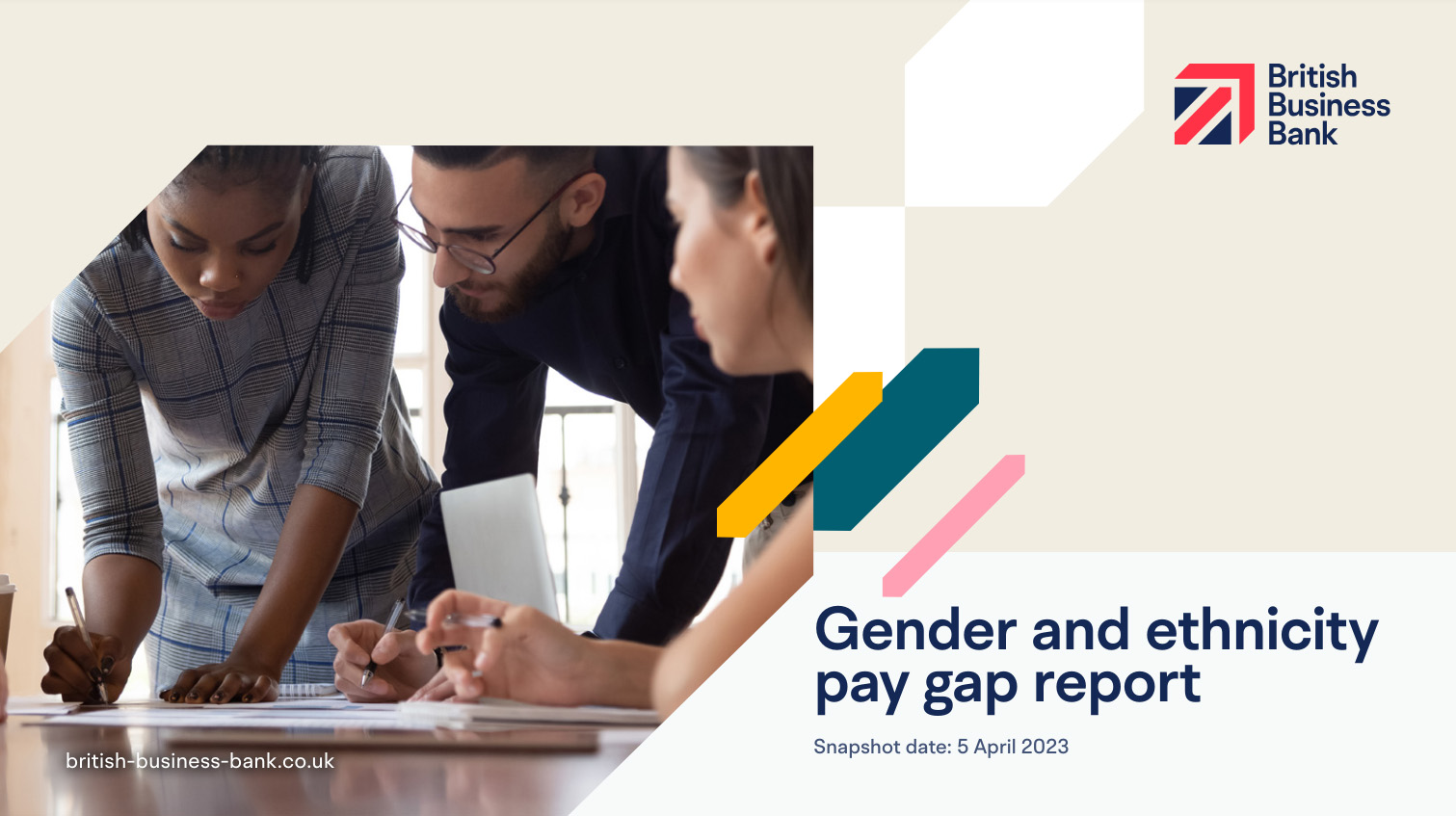
Gender and ethnicity pay gap report 2023
Our 2023 ethnicity pay gap at a glance
Proportion of White and Other Ethnic Minority colleagues in each pay quartile
| Headcount | Percentages | |||
|---|---|---|---|---|
| Quartile | White | Black, Asian, Mixed or Multiple Ethnic groups and Other Ethnic backgrounds | White | Black, Asian, Mixed or Multiple Ethnic groups and Other Ethnic backgrounds |
| Upper quartile |
105 |
19 |
84.7 |
15.3 |
| Upper middle quatile |
100 |
25 |
80 |
20 |
| Lower middle quartile |
102 |
23 |
81.6 |
18.4 |
| Lower quartile |
83 |
41 |
66.9 |
33.1 |
Each pay quartile represents a quarter, or 25%, of our total workforce ranked by pay
Ethnicity pay gap (As a % of mean/median white pay)
| White | Black, Asian, Mixed or Multiple Ethnic groups and Other Ethnic backgrounds | Pay gap | |
|---|---|---|---|
| Median hourly rate | £28.47 | £24.57 | 13.7% |
| Median annual salary | £55,715 | £48,087 | 13.7% |
The difference in our median pay for different ethnic groups
| White | Black, Asian, Mixed or Multiple Ethnic groups and Other Ethnic backgrounds | Pay gap | |
|---|---|---|---|
| Mean hourly rate | £32.61 | £27.69 | 15.1% |
| Mean annual salary | £63.813 | £54.176 | 15.1% |
Our mean and median pay gaps by ethnicity
| Ethnicity Group | Number of colleagues who disclosed ethnicity | Median % | Mean % |
|---|---|---|---|
| Asian or Asian British | 67 | 14.1 | 14.8 |
| Black or Black British | 21 | 36 | 29.4 |
| Mixed or Multiple Ethnic groups and Other Ethnic Minority backgrounds | 20 | -10.6 | 1 |
| Total Black, Asian, Mixed or Multiple Ethnic groups or Other Ethnic Minority backgrounds | 108 | 13.7 | 15.1 |
Ethnicity bonus gap (As a % of mean/median White bonus)
| Element | 2023 |
|---|---|
| Median % | 28.0 |
| Mean % | 36.4 |
Proportion of White and Black, Asian, Mixed or Multiple Ethnic groups and Other Ethnic Minority background colleagues
| Element | 2023 |
|---|---|
| Median % | 28.0 |
| Mean % | 36.4 |
Proportion of White colleagues and Black, Asian, Mixed or Multiple Ethnic groups and Other Ethnic Minority background colleagues receiving bonuses
| Ethnicity Group | 2023 |
|---|---|
| White % | 78.3 |
| Black, Asian, Mixed or Multiple Ethnic groups or Other Ethnic Minority backgrounds % | 21.7 |
All figures are based upon 565 employees at the snapshot date of 5 April 2023.
Reporting ethnicity pay gaps - an overview
The UK workforce reflects the UK’s increasingly diverse society but there is still more to be done to remove barriers to entering the labour market and to ensure pay and progression in the workplace is fair for all ethnic groups.
While ethnicity pay reporting is voluntary, many employers already report on their ethnicity pay data. In April 2023, the government released their first guidance which sets out a consistent approach to measuring pay differences.
Guidance for ethnicity pay reporting recommends that those publishing ethnicity data report in the same way that organisations in the UK are required to report on gender pay gaps, using the following six measures:
Median ethnicity pay gap – the difference between the median hourly rate of pay of white full-pay relevant colleagues and that of full-pay relevant colleagues from other ethnic backgrounds.
Median ethnicity bonus gap – the difference between the median bonus paid to white relevant colleagues and that paid to relevant colleagues from other ethnic minority backgrounds.
Bonus proportions – the proportions of relevant colleagues from white and other ethnic minority backgrounds who were paid bonus during the relevant period.
Mean (average) ethnicity pay gap – the difference between the mean hourly rate of pay of white fullpay relevant colleagues and that of full-pay relevant colleagues from other ethnic backgrounds.
Mean (average) ethnicity bonus gap – the difference between the mean bonus paid to white relevant colleagues and that paid to relevant colleagues from other ethnic minority backgrounds.
Quartile pay bands – the proportions of full-pay relevant colleagues from white and other ethnic minority backgrounds in the lower, lower-middle, upper-middle and upper quartile pay bands.
Additional definitions
Mean is the average of a set of numbers is calculated by adding up all the values and then dividing the sum by the total number of values.

Median is a measure of central tendency in a set of data. It represents the middle value when the data set is ordered or ranked.
Hourly pay is the total of salary and any cash allowances paid, before any deductions for tax, calculated as an hourly rate. The figure used for the 2023 gender pay gap is the hourly pay for April 2023. Colleagues who did not receive their normal full pay during that month for any reason are excluded from the calculation.
Bonus for the purpose of calculating the bonus gap is the total bonus and/or long-term incentive paid during the previous 12 months to all colleagues who were employed on the snapshot date of 5 April 2023. For the Bank, this means bonus payments made in June and August 2022 in respect of the financial year ending 31 March 2022, and long-term incentive payments made in August 2022 in respect of the three-year performance cycle that ended in March 2022.
What is our ethnicity pay gap
Colleague profile
In the UK we had 565 colleagues on the snapshot date of 5 April 2023. 88.1% (498) of our colleagues openly disclosed their ethnicity to us. Of those, 390 (78.3%) are White (including White British, White Irish and any other White colleagues) and 108 (21.7%) are from Black, Asian, Mixed or Multiple Ethnic groups or Other Ethnic Minority backgrounds. We are pleased to have such a high disclosure rate as we work towards an inclusive and open culture
Our ethnicity pay gap
Our analysis shows that the median ethnicity pay gap between White and Black, Asian, Mixed or Multiple Ethnic groups and Other Ethnic Minority backgrounds’ earnings is 13.7%, based on hourly rates of pay at the snapshot date. Our mean ethnicity pay gap is 15.1%.
The ethnicity pay gap is calculated as the difference between average hourly earnings of White and Black, Asian, Mixed or Multiple Ethnic groups and Other Ethnic Minority backgrounds as a proportion of White colleague’s average hourly earnings. It is a measure across all jobs in the company, not of the difference in pay between White and Black, Asian, Mixed or Multiple Ethnic groups and Other Ethnic Minority backgrounds’ for doing the same job.
The factors influencing the Bank’s ethnicity pay gap are likely largely similar to those impacting our gender pay gap. We have lower ethnic minority representation in senior leadership positions (Bands 1 to 5) that attract a higher rate of pay, compared to White colleague representation.
Only 16.1% (42) of the senior leadership positions are filled by colleagues from Black, Asian, Mixed or Multiple Ethnic groups and Other Ethnic Minority backgrounds compared to 27.8% (66) of colleagues at the junior level (Bands 6 and 7).
We are confident we pay colleagues fairly and equally in the same and similar roles, but in a relatively small organisation like the Bank, small changes in our demographics and the levels and pay grades at which people operate have a significant impact on our figures.

Our ethnicity bonus gap
The median ethnicity bonus gap between White and Black, Asian, Mixed or Multiple Ethnic groups and Other Ethnic Minority backgrounds’ bonus payments is 28.0%. Our mean ethnicity bonus gap is 36.4%.
The 2023 ethnicity bonus gap reflects bonus payments made in June and August 2022, in respect of the financial year ending 31 March 2022. During this period, 56.4% (62) of Black, Asian, Mixed or Multiple Ethnic groups and Other Ethnic Minority backgrounds’ colleagues, and 71.4% (284) of White colleagues received a bonus. Only colleagues who joined the Bank on or before 31 December 2021 were eligible, and the proportion of colleagues receiving a bonus closely reflected the proportion who were eligible for a bonus or long-term incentive award. The Bank continued to grow rapidly during the bonus year, which is why – for both White and Black, Asian, Mixed or Multiple Ethnic groups and Other Ethnic Minority backgrounds’ – a portion of joiners (155 (30.5%)) were not eligible for a bonus.
As outlined earlier in the ‘What is our Gender Pay Gap?’ section there are several factors that can influence the level of an individual colleague’s bonus or long-term incentive award, and these remain the case in relation to our ethnicity bonus gap.
On this basis, we are confident that our ethnicity bonus gap is due to structural factors such as the proportion of White and Black, Asian, Mixed or Multiple Ethnic groups and Other Ethnic Minority backgrounds in senior roles, rather than to any ethnicity-related bias. We remain committed to ensuring that all pay, and bonus decisions are free of any form of bias through a combination of line manager training, clear guidance, and robust governance.